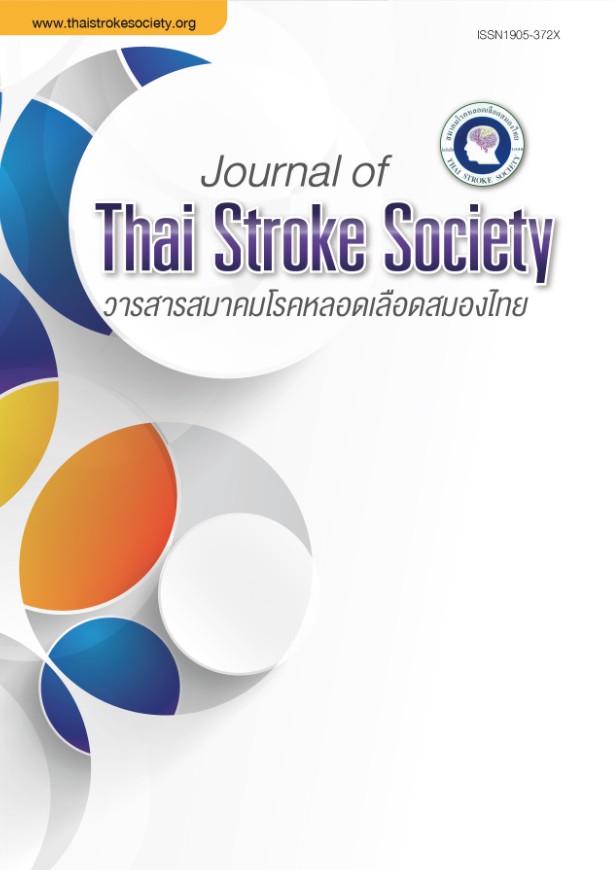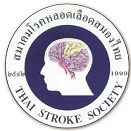HIV infection and stroke
Keywords:
human immunodeficiency virus, stroke, epidemiology, mechanism, managementAbstract
The combined antiretroviral therapy (cART) and comprehensive care have prolonged lifespan of persons living with human immunodeficiency virus (HIV). Several diseases associated with aging including cardiovascular diseases, chronic kidney diseases, chronic liver diseases and malignancies have emerged as important comorbidities in this population. Stroke is one of the aging cerebrovascular diseases that may occur coincidentally with or occur as a result of HIV infection. Direct mechanisms of HIV-related stroke include chronic inflammation-associated atherosclerosis, hypercoagulability and vasculopathy while indirect mechanisms are HIV-related opportunistic infections, cART-related adverse reactions and cardioembolism. Presentations of stroke in persons with and without HIV infection are generally similar; however, data for stroke management in HIV-infected population are currently limited. Stroke management and prevention should include identification and treatment of the specific etiology of stroke and relevant risk factors along with cART. Here, the epidemiology, pathogenesis, risk factors, clinical presentations, and management of HIV-associated stroke are reviewed.
References
STDS 2014; 28: 517-523.
Lo J, Plutzky J. The biology of atherosclerosis: general paradigms and distinct pathogenic mechanisms among HIV-infected patients. J Infect Dis 2012; 205 Suppl 3: S368-374.
Benjamin LA, Bryer A, Emsley HC, et al. HIV infection and stroke: current perspectives and future directions. Lancet Neurol 2012; 11: 878-890.
Feigin VL, Lawes CM, Bennett DA, et al. Worldwide stroke incidence and early case fatality reported in 56 population-based studies: a systematic review.
Lancet Neurol 2009; 8: 355-369.
Ovbiagele B, Nath A. Increasing incidence of ischemic stroke in patients with HIV infection. Neurology 2011; 76: 444-450.
Cole JW, Pinto AN, Hebel JR, et al. Acquired immunodeficiency syndrome and the risk of stroke. Stroke 2004; 35: 51-56.
Rasmussen LD, Engsig FN, Christensen H, et al. Risk of cerebrovascular events in persons with and without HIV: a Danish nationwide population-based
cohort study. AIDS 2011; 25: 1637-1646.
Berger JR, Harris JO, Gregorios J, et al. Cerebrovascular disease in AIDS: a case-control study. AIDS 1990; 4: 239-244.
Hoffmann M, Berger JR, Nath A, et al. Cerebrovascular disease in young, HIV-infected, black Africans in the KwaZulu Natal province of South Africa. J Neurovirol 2000; 6: 229-236.
Patel VB, Sacoor Z, Francis P, et al. Ischemic stroke in young HIV-positive patients in Kwazulu-Natal, South Africa. Neurology 2005; 65: 759-761.
Nair R, Abdool-Carrim A, Chetty R, et al. Arterial aneurysms in patients infected with human immunodeficiency virus: a distinct clinicopathology entity? J Vasc Surg. 1999; 29: 600-607.
Chetty R. Vasculitides associated with HIV infection. J Clin Pathol 2001; 54: 275-278.
Gherardi R, Belec L, Mhiri C, et al. The spectrum of vasculitis in human immunodeficiency virus-infected patients. A clinicopathologic evaluation. Arthritis
Rheum 1993; 36: 1164-1174.
Sen S, Rabinstein AA, Elkind MS, et al. Recent developments regarding human immunodeficiency virus infection and stroke. Cerebrovasc Dis 2012; 33: 209-218.
Maniar A, Ellis C, Asmuth D, et al. HIV infection and atherosclerosis: evaluating the drivers of inflammation. Eur J Prev Cardiol 2013; 20: 720-728.
Kuller LH, Tracy R, Belloso W, et al. Inflammatory and coagulation biomarkers and mortality in patients with HIV infection. PLoS Med 2008; 5: e203.
Kline ER, Sutliff RL. The roles of HIV-1 proteins and antiretroviral drug therapy in HIV-1-associated endothelial dysfunction. J Investig Med 2008; 56:
752–769.
Lo J, Plutzky J. The biology of atherosclerosis: general paradigms and distinct pathogenic mechanisms among HIV-infected patients. J Infect Dis 2012; 205 (suppl 3): S368–3674.
Chi D, Henry J, Kelley J, et al. The effects of HIV infection on endothelial function. Endothelium 2000; 7: 223–242.
Ross AC, Rizk N, O’Riordan MA, et al. Relationship between inflammatory markers, endothelial activation markers, and carotid intima-media thickness in HIV-infected patients receiving antiretroviral therapy. Clin Infect Dis 2009; 49: 1119–1127.
Schved JF, Gris JC, Arnaud A, et al. von Willebrand factor antigen, tissue-type plasminogen activator antigen, and risk of death in human immunodeficiency virus 1-related clinical disease: independent prognostic relevance of tissue-type plasminogen activator. J Lab Clin Med 1992; 120: 411–419.
Neuhaus J, Jacobs DR Jr, Baker JV, et al. Markers of inflammation, coagulation, and renal function are elevated in adults with HIV infection. J Infect Dis
2010; 201: 1788–1795.
Zareba KM, Lipshultz SE. Cardiovascular complications in patients with HIV infection. Curr Infect Dis Rep 2003; 5: 513-520.
Baker JV. Chronic HIV disease and activation of the coagulation system. Thromb Res 2013; 132: 495-499.
Lammie GA, Hewlett RH, Schoeman JF, et al. Tuberculous cerebrovascular disease: a review. J Infect 2009; 59: 156-166.
Zetola NM, Engelman J, Jensen TP, et al. Syphilis in the United States: an update for clinicians with an emphasis on HIV coinfection. Mayo Clin Proc 2007;
82: 1091-1102.
Mizusawa H, Hirano A, Llena JF, et al. Cerebrovascular lesions in acquired immune deficiency syndrome (AIDS). Acta Neuropathol 1988; 76: 451-457.
Ortiz G, Koch S, Romano JG, et al. Mechanisms of ischemic stroke in HIV-infected patients. Neurology 2007; 68: 1257–1261.
Mochan A, Modi M, Modi G. Stroke in black South African HIV-positive patients: a prospective analysis. Stroke 2003; 34: 10–15.
de Gaetano Donati K, Rabagliati R, Tumbarello M, et al. Increased soluble markers of endothelial dysfunction in HIV-positive patients under highly active antiretroviral therapy. AIDS 2003; 17: 765–768.
Ross AC, Rizk N, O’Riordan MA, et al. Relationship between inflammatory markers, endothelial activation markers, and carotid intima-media thickness in
HIV-infected patients receiving antiretroviral therapy. Clin Infect Dis 2009; 49: 1119–1127.
Corral I, Quereda C, Moreno A, et al. Cerebrovascular ischemic events in HIV-1-infected patients receiving highly active antiretroviral therapy: incidence and risk factors. Cerebrovasc Dis 2009; 27: 559–563.
Lipshultz SE, Mas CM, Henkel JM, et al. HAART to heart: highly active antiretroviral therapy and the risk of cardiovascular disease in HIV-infected or
exposed children and adults. Expert Rev Anti Infect Ther 2012; 10: 661-674.
Cruciani M, Zanichelli V, Serpelloni G, et al. Abacavir use and cardiovascular disease events: a metaanalysis of published and unpublished data. AIDS 2011; 25: 1993–2004.
Harmsen P, Lappas G, Rosengren A, et al. Long-term risk factors for stroke: twenty-eight years of follow-up of 7457 middle-aged men in Göteborg, Sweden.
Stroke 2006; 37: 1663-1667.
Hankey GJ. Potential new risk factors for ischemic stroke: what is their potential? Stroke 2006; 37: 2181-8.
Grysiewicz RA, Thomas K, Pandey DK. Epidemiology of ischemic and hemorrhagic stroke: incidence, prevalence, mortality, and risk factors. Neurol Clin 2008; 26: 871-895.
Jerrard-Dunne P, Cloud G, Hassan A, et al. Evaluating the genetic component of ischemic stroke subtypes: a family history study. Stroke 2003; 34: 1364-1369.
Jood K, Ladenvall C, Rosengren A, et al. Family history in ischemic stroke before 70 years of age: the Sahlgrenska Academy Study on Ischemic Stroke. Stroke 2005; 36: 1383-1387.
Meschia JF, Worrall BB, Rich SS. Genetic susceptibility to ischemic stroke. Nat Rev Neurol 2011; 7: 369-378.
Howard VJ. Reasons underlying racial differences in stroke incidence and mortality. Stroke 2013; 44: S126-128.
Chomistek AK, Manson JE, Stefanick ML, et al. Relationship of sedentary behavior and physical activity to incident cardiovascular disease: results
from the Women’s Health Initiative. J Am Coll Cardiol 2013; 61: 2346-2354.
Gillum RF, Mussolino ME, Ingram DD. Physical activity and stroke incidence in women and men. The NHANES I Epidemiologic Follow-up Study. Am J
Epidemiol 1996; 143: 860-9.
Wolf PA, D’Agostino RB, Belanger AJ, Kannel WB. Probability of stroke: a risk profile from the Framingham Study. Stroke 1991; 22: 312-318.
Lee B, Anekthananon T, Poungvarin N, et al. Etiology and risk factors of stroke in HIV-infected patients in Siriraj Hospital: a case-control study. J Med Assoc Thai 2012; 95 Suppl 2: S227-234.
Tipping B, de Villiers L, Wainwright H, et al. Stroke in patients with human immunodeficiency virus infection. J Neurol Neurosurg Psychiatr 2007; 78: 1320-1324.
Sharfstein SR, Ahmed S, Islam MQ, et al. Case of moyamoya disease in a patient with advanced acquired immunodeficiency syndrome. J Stroke Cerebrovasc
Dis 2007; 16: 268–272.
Melica G, Brugieres P, Lascaux AS, et al. Primary vasculitis of the central nervous system in patients infected with HIV-1 in the HAART era. J Med Virol 2009; 81: 578–581.
Bhagavati S, Choi J. Rapidly progressive cerebrovascular stenosis and recurrent strokes followed by improvement in HIV vasculopathy. Cerebrovasc Dis 2008; 26: 449–452.
Bamford J, Sandercock P, Dennis M, et al. Classification and natural history of clinically identifiable subtypes of cerebral infarction. Lancet 1991; 337: 1521–1526.
Jauch EC, Saver JL, Adams HP Jr, et al. Guidelines for the early management of patients with acute ischemic stroke: a guideline for healthcare professionals from the American Heart Association/American Stroke Association. Stroke 2013; 44: 870-947.
Centers for Disease Control and Prevention, National Institutes of Health, and the HIV Medicine Association of the Infectious Diseases Society of America. Guidelines for the prevention and treatment of opportunistic infections in HIV-infected adults and adolescents. Available at http://aidsinfo.nih.gov/guidelines. Accessed 1 June 2015.
World Health Organization. Consolidated guidelines on the use of antiretroviral drugs for treating and preventing HIV infection. Available at http://www.who.int/hiv/pub/guidelines/arv2013/download/en/.Accessed 1 June 2015.
Thai AIDS Soceity. Thailand National Guidelines on HIV/AIDS Treatment and Prevention 2014. Available at http://www.thaiaidssociety.org/images/PDF/hiv_
guideline_2557.pdf. Accessed 1 June 2015.
Bozzette SA, Ake CF, Tam HK, et al. Cardiovascular and cerebrovascular events in patients treated for human immunodefi ciency virus infection. N Engl J
Med 2003; 348: 702–710.
Bozzette SA. HIV and cardiovascular disease. Clin Infect Dis 2011; 53: 92–93.
Kernan WN, Ovbiagele B, Black HR, et al. Guidelines for the prevention of stroke in patients with stroke and transient ischemic attack: a guideline for
healthcare professionals from the American Heart Association/American Stroke Association. Stroke 2014; 45: 2160-2236.
Stone NJ, Robinson JG, Lichtenstein AH, et al. 2013 ACC/AHA guideline on the treatment of blood cholesterol to reduce atherosclerotic cardiovascular risk in adults: a report of the American College of Cardiology/American Heart Association Task Force on Practice Guidelines. Circulation 2014; 129: S1-45.
Broderick J, Connolly S, Feldmann E, et al. Guidelines for the management of spontaneous intracerebral hemorrhage in adults: 2007 update: a guideline from
the American Heart Association/American Stroke Association Stroke Council, High Blood Pressure Research Council, and the Quality of Care and Outcomes in Research Interdisciplinary Working Group. Stroke 2007; 38: 2001-2023.
Downloads
Published
How to Cite
Issue
Section
License
ข้อความภายในบทความที่ตีพิมพ์ในวารสารสมาคมโรคหลอดเลือดสมองไทยเล่มนี้ ตลอดจนความรับผิดชอบด้านเนื้อหาและการตรวจร่างบทความเป็นของผู้นิพนธ์ ไม่เกี่ยวข้องกับกองบรรณาธิการแต่อย่างใด การนำเนื้อหา ข้อความหรือข้อคิดเห็นของบทความไปเผยแพร่ ต้องได้รับอนุญาตจากกองบรรณาธิการอย่างเป็นลายลักษณ์อักษร ผลงานที่ได้รับการตีพิมพ์ในวารสารเล่มนี้ถือเป็นลิขสิทธิ์ของวารสาร





